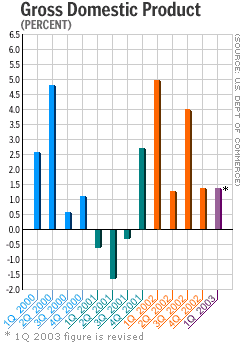NEW YORK (CNN/Money) -
Will the "kitchen sink" approach really fix the economy?
Policy makers in the federal government and the Federal Reserve have thrown everything but the kitchen sink at the ailing economy, and most economists are saying their efforts will spur relatively robust economic growth in the second half.
After growing at a paltry 1.4 percent rate in the first quarter and probably not much better in the second, gross domestic product (GDP) is expected to grow at a rate of 3.4 percent in both the third and fourth quarters, according to the Philadelphia Fed's latest survey of professional forecasters.
Of course, economic forecasters have often been overly optimistic since early 2001, when a recession/jobless recovery cycle began, and have been forced many times to ratchet down their expectations.
"All the good growth is in the forecasts, in the idea that financial conditions have eased," said Rory Robertson, interest-rate strategist at Macquarie Equities (USA). "But we've seen that doesn't always turn into actual good growth."
Still, Robertson and other economists have a little more reason to hope that this time might be different, thanks to a combination of:
- the recently-signed tax-cut plan, which will give rebate checks to families with children in late summer, right in time for back-to-school spending;
- improving consumer confidence -- critical, since consumer spending makes up more than two-thirds of the economy;
- the Fed's 13th rate cut of the cycle, taking the fed funds rate to 45-year lows;
- a weakened dollar, which should help make U.S. exports more competitive overseas; and
- a healthier stock market, making consumers feel wealthier.
Of course, there are flaws in just about all of these boosters, including:
- federal tax cuts could be offset by state and local tax hikes and layoffs;
- much of the tax-cut benefit goes to wealthier Americans, who might be more likely to save it;
- consumers don't always spend the way they feel;
- the Fed's rate cut disappointed the bond market and caused a jump in long-term interest rates, the opposite of what the Fed intended; and
- the smaller-than-expected rate cut also caused the dollar to regain some value.
The biggest problem with the rosy scenario, however, is that businesses have yet to get on board the hope train -- they're still not expanding operations or hiring workers, two activities critical to economic strength in the near future.

"Business spending is the Achilles heel of the economy," said Sung Won Sohn, chief economist at Wells Fargo & Co. "The economic baton needs to pass from consumers to businesses."
The hope is that a bump in consumer confidence and spending in the second half, along with ever-improving profits, will finally convince businesses it's OK to go back in the water.
Unfortunately, that process might not happen overnight, according to Rajeev Dhawan, Director of the Economic Forecasting Center at Georgia State University in Atlanta, who expects third- and fourth-quarter GDP growth rates of just 1.8 percent and 2.9 percent, respectively.
"If consumer confidence holds steady, and consumers spend the money from tax cuts, and once business see a clear sign of a rebound in sales, then around September or October, they're going to budget and change their targets for capital spending," Dhawan said. "Then, it takes a couple of months to hire people and get set up."
In the meantime, the unemployment rate has risen to a nine-year high of 6.4 percent, and could go even higher, as signs of an economic spring cause long-unemployed workers to renew their job searches.
| Related stories
|

|
|
|
|
The reason? There are millions of discouraged workers sitting on the sidelines, not looking for jobs anymore, and they aren't counted among the "unemployed" by the Labor Department. When they start looking for work again, however, they become, officially, "unemployed," and the jobless rate climbs.
The unemployment rate will also be supported by the fact that, during the recent lean years, many companies have learned to produce more with fewer workers.
What's more, many companies still have way too much production capacity -- the buildings, computers and equipment with which they make stuff. They loaded up on it in the late 1990s, when demand was strong and the future seemed bright, and now they're stuck with it, giving them little reason to invest in more.
All this excess capacity and slack in the labor market means there's little demand, which is keeping wages and prices low. The Fed's nightmare is that the economy might keep growing, but never fast enough to stay out of the spiral of deflation, an unstoppable drop in prices that sinks corporate profits.
In a research note this week, Citigroup chief economist Robert DiClemente said that, even if GDP grows at a 4 percent rate in the near future, as he expects it will, that still won't be strong enough to take up the slack in the economy and keep inflation from falling to zero, setting the stage for future deflation.
"True, the fuel for faster recovery is amassing," DiClemente wrote. "But that prospect does not materially alter chances that inflation will also remain well anchored."

|

